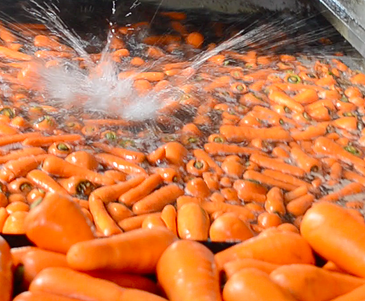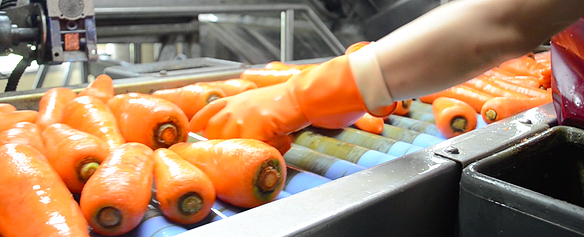The carrot (Daucus carota L.) belongs to the family Apiaceae. It is related to celery, celeriac, coriander, fennel, parsnip and parsley, which are all members of this family. The carrot originated in Asia. Initially the roots were long and thin, and either purple or yellow in colour. These colours, as well as white and orange, still exist, with the orange or orange-red colours being by far the most popular today. Many shapes of roots also exist, from rather long and thin roots to shorter and thick. Roots may be cylindrical, conical, or even spherical in shape.
Carrots are particularly rich in carotene (pro-vitamin A). They are consumed either fresh, as a salad crop, or cooked. Large quantities are also processed, either alone or in mixtures with other vegetables, by canning, freezing or dehydration.
The carrot is a very important vegetable crop in South Africa. Judging by seed usage, it is among the top ten vegetable crops on an area basis. In KwaZulu-Natal it is probably one of the five most important vegetable crops grown.
The plant is a biennial, i.e. it grows vegetatively in the first season and produces seed in the second. For root production the plant is grown as an annual. Low temperatures, as well as various stress factors, will sometimes cause flower production to be initiated, particularly in certain selections of some varieties. Bolting to seed in spring is possible in carrot plantings grown over the winter period.
sources:http://www.kzndard.gov.za/images/Documents/Horticulture/Veg_prod/carrots.pdf
 Diets rich in beta carotene are also thought to reduce the risk of certain cancers, cardiovascular diseases and smoking-related conditions. In a study of elderly individuals, those who ate at least one serving of carrots or squash per day reduced their rate of heart attack by 60 percent. A Harvard study showed that those who eat five carrots a week are less likely to suffer a stroke than those who eat one per month. High carotenoid intake has been associated with decreases in the incidences of breast, bladder, cervical, prostate and colon cancer, among others. Smoking cigarettes produces a vitamin A deficiency; consuming beta carotene-rich foods like carrots can help ward off associated conditions like emphysema.
Diets rich in beta carotene are also thought to reduce the risk of certain cancers, cardiovascular diseases and smoking-related conditions. In a study of elderly individuals, those who ate at least one serving of carrots or squash per day reduced their rate of heart attack by 60 percent. A Harvard study showed that those who eat five carrots a week are less likely to suffer a stroke than those who eat one per month. High carotenoid intake has been associated with decreases in the incidences of breast, bladder, cervical, prostate and colon cancer, among others. Smoking cigarettes produces a vitamin A deficiency; consuming beta carotene-rich foods like carrots can help ward off associated conditions like emphysema.Soil Conditions
Carrots favour well-drained, fine textured soils with good water-holding capacity. Sandy, loamy or muck-based soils are suitable for carrot production. A pH range of 5.5 to 8.0 is desirable. Carrot seedlings are very weak, and do not tolerate soil crusting. Seedbed preparation must eliminate clods as they interfere with uniform growth of the roots. Since the taproot is the edible portion of the plant, the field should be tilled to a 30 cm (12 inches) deep to ensure that root penetration is not restricted. Crusting of the soil surface will prevent the seedlings from emerging. For this reason, avoid clay soils.
Raised beds are very popular in carrot production as they help the soil warm up faster in the spring, promoting faster emergence. The soil tends to be very soft in the beds, which is crucial for weaker carrot seedlings.
Seed costs have increased over the last 10 years. One reason is the higher quality seed currently produced. It was once thought that a 50 per cent stand was good in carrot production, but better varieties and superior seed production practices now have increased that figure to 80 per cent or more. Due to the seed's higher value, it is best to treat it with a fungicide, such as Thiram 75WP, to prevent seedling blight, damping off and seed decay.
Pelleting carrot seed to increase its size improves the accuracy of planting and the uniformity of the carrot stand. Consult your local seed representative to get more information on precision seeding and seed pelleting.
Seed Treatment
Seed costs have increased over the last 10 years. One reason is the higher quality seed currently produced. It was once thought that a 50 per cent stand was good in carrot production, but better varieties and superior seed production practices now have increased that figure to 80 per cent or more. Due to the seed's higher value, it is best to treat it with a fungicide, such as Thiram 75WP, to prevent seedling blight, damping off and seed decay.
Pelleting carrot seed to increase its size improves the accuracy of planting and the uniformity of the carrot stand. Consult your local seed representative to get more information on precision seeding and seed pelleting.
Fertility
Always base your fertilizer program on a soil test. Random soil samples should be collected from the entire field that you intend to plant. Due to climatic conditions, differing cultural practices, varying soil conditions and other situations, the crop's response to the fertility program may vary from region to region.
Carrots will require 80 kg/ha (71 lbs/ac) of nitrogen on muck soils, and 110 kg/ha (98 lbs/ac) of nitrogen on mineral soils. Phosphorus and potassium will be required in 120 kg/ha and 250 kg/ha (107 lbs/ac and 223 lbs/ac) amounts respectively. Always base your fertilizer rates on a soil test.
Over-application of nitrogen can lead to excess top-growth, which will slow the growth and development of the edible taproot.
Sources:http://www.saskatchewan.ca/business/agriculture-natural-resources-and-industry/agribusiness-farmers-and-ranchers/crops-and-irrigation/horticultural-crops/vegetables/carrot-production
